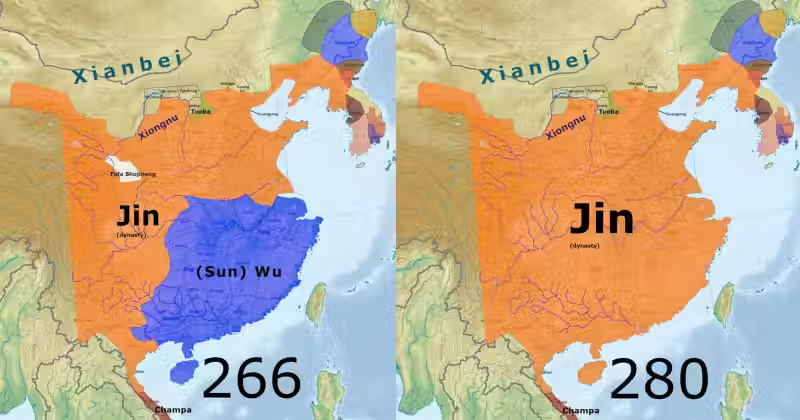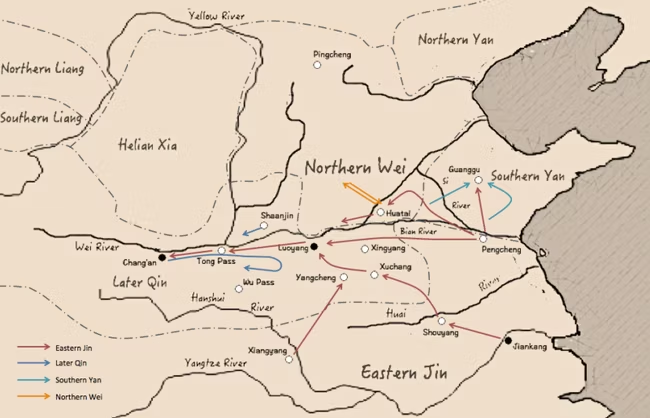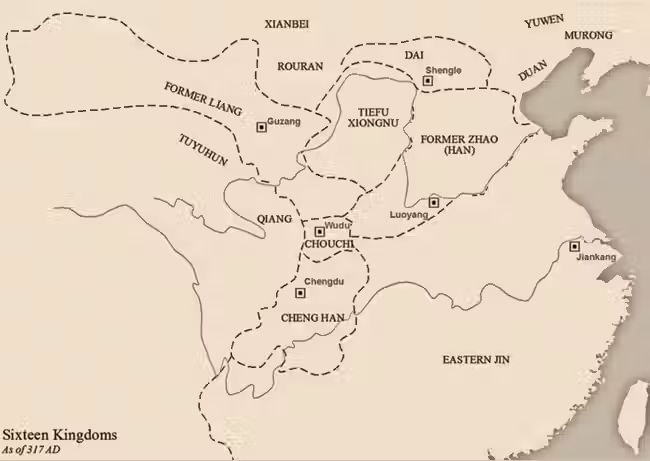Chinese Dynasty: Jin Dynasty (266-420 CE) - Western and Eastern Jin
The Jin Dynasty (晋朝, Jìn) was established in 266 CE by Sima Yan (司马炎), who became Emperor Wu of Jin (晋武帝). It marked a crucial transition in Chinese history, following the tumultuous Three Kingdoms period (三国). The dynasty lasted for nearly 160 years and can be divided into two major phases: the Western Jin (西晋, 266-316 CE) and the Eastern Jin (东晋, 317-420 CE).
During around the same period of the Eastern Jin, there were the Sixteen Kingdoms of the Five Barbarians (五胡十六国, 304-439 CE) in northern China.
Western Jin (266-316 CE)
The Western Jin (西晋), together with the later Eastern Jin (东晋), was collectively known as the Jin Dynasty. The Western Jin was a unified dynasty in Chinese history following the Three Kingdoms period. It represented a brief period of unity amidst the prolonged division of the Wei (魏, 220-266 CE), Jin (晋), and Northern and Southern Dynasties (南北朝, 420-589 CE).
Establishment

Maps showing the establishment of Jin in 266 CE (left) and the unification in 280 CE (right)
During the Three Kingdoms period, the Sima clan, led by their most accomplished individual Sima Yi (司马懿), rose to prominence within the Cao Wei kingdom (曹魏), which held dominion over northern China under the rule of the Cao clan. As the regent of Cao Wei, Sima Yi orchestrated a coup d'état known as the Incident at the Gaoping Tombs (高平陵之变) in 249 CE, propelling the Sima clan to surpass the Cao clan in power. Following Sima Yi's death in 251 CE, his sons successively carried on the legacy of the Sima clan, consolidating and expanding their influence.
In 263 CE, Sima Yi's son, Sima Zhao (司马昭), commanded the Cao Wei forces in the conquest of Shu Han (蜀汉), marking the first downfall of the Three Kingdoms. Sima Zhao's achievements earned him the title of King of Jin (晋王), the highest rank attainable below that of the emperor. Although Sima Zhao harbored ambitions for the imperial throne, he passed away not long after in 265 CE.
Following Sima Zhao's death, his son Sima Yan (司马炎) succeeded as the King of Jin and regent of Cao Wei. In 266 CE, he compelled Cao Huan (曹奂), the last ruler of Cao Wei, to abdicate, and declare himself emperor, establishing the Jin Dynasty (晋朝). Sima Yan was posthumously known as Emperor Wu of Jin (晋武帝).
Unification and Short-Lived Stability
During the reign of Emperor Wu, the Jin Dynasty achieved a significant victory by conquering Eastern Wu (东吴) in 280 CE, thereby unifying China proper and effectively bringing an end to the era of the Three Kingdoms (三国).
However, the period of unity proved to be relatively brief as the Jin state faced subsequent challenges in the form of corruption, political upheaval, and internal strife, which gradually weakened the dynasty.

War of the Eight Princes in Western Jin (291-306 CE)
Emperor Wu died in 290 CE, and his son Sima Zhong (司马衷), posthumously known as Emperor Hui of Jin (晋惠帝), took the throne but was developmentally disabled. In 291 CE conflicts over Emperor Wu's succession caused the devastating War of the Eight Princes (八王之乱, 291-306 CE).
The War of the Eight Princes was a political power struggle that escalated into a severe internal conflict among the imperial family, resulting in one of the most significant internal upheavals in Chinese history.
The unrest eventually led to warfare and had widespread consequences throughout society. It caused immense destruction and exacerbated the ruling crisis of the Western Jin, becoming a crucial factor in its rapid downfall.

Uprising of the Five Barbarians in Western Jin (304-316 CE)
During the War of the Eight Princes, various tribes of northern ethnic minorities, including the Xiongnu (匈奴), Jie (羯), Xianbei (鲜卑), Qiang (羌), and Di (氐), took advantage of the power vacuum within the Western Jin regime. They rebelled and established separatist regimes, occupying the Central Plains. Eventually, in 316 CE, the Western Jin collapsed. The surviving members of the Jin royal family sought refuge in the Central Plains and established a new dynasty in the southern region known as the Eastern Jin Dynasty, with Jiankang (建康) as its capital.
Meanwhile, the Central Plains in the northern region fell under the control of various ethnic minorities and nomadic tribes, both Han and non-Han, who established sixteen different states (十六国), with the Xianbei tribes' successive regimes exerting the most significant influence. These ethnic tribes were collectively referred to as the Five Barbarians (五胡).
In general, this period in Chinese history is known as the era of the Sixteen Kingdoms of the Five Barbarians (五胡十六国).
The division between the northern and southern regions persisted throughout the Eastern Jin Dynasty and the subsequent Northern and Southern Dynasties (南北朝) until 589 CE when the Sui Dynasty (隋朝) successfully reunified China under a single unified dynasty.
Eastern Jin (317-420 CE)
The Eastern Jin Dynasty (东晋) was a critical period in Chinese history that followed the division of the Jin Dynasty into two factions. This era witnessed significant political challenges as the empire grappled with internal strife, external invasions, and a continuous struggle for power.
Establishment

Left: Eastern Jin (yellow) and Former Qin (blue) in 376 CE. Right: administrative divisions of Eastern Jin in 382 CE.
Following the collapse of Chang'an and the execution of Emperor Min of Jin (晋愍帝), Sima Rui (司马睿), honored posthumously as Emperor Yuan of Jin (晋元帝), ascended to the throne as the emperor in 318 CE. He established the new capital of the Jin government in Jiankang (建康), which marked the beginning of the Eastern Jin period.
The Eastern Jin period was characterized by the prominence of menfa (门阀 or 士族, "gentry clans") politics. The emperors held limited authority, while influential immigrant elite clans such as the Wang clans (王氏) of Langya (琅玡) and Taiyuan (太原), the Xie clan (谢氏) of Chenjun (陈郡), the Huan clan (桓氏) of Qiao Commandery (谯国), and the Yu clan (庾氏) of Yingchuan (颍川) exerted control over national affairs. It was commonly remarked among the people that "Wang and Sima dominate the nation together" (王与马,共天下).
Northern Expeditions and Internal Unrest

Liu Yu's Northern Expeditions (409-416 CE)
In an effort to reclaim the territories lost during the collapse of the Western Jin, the Eastern Jin Dynasty embarked on multiple military campaigns against the northern states. One notable series of expeditions was led by Huan Wen (桓温) from 354 to 369 CE. However, despite some successes, Eastern Jin faced challenges in maintaining support for these campaigns due to internal disruptions and paranoia within the royal family.
A significant turning point occurred in 383 CE when a greatly outnumbered Eastern Jin force achieved a resounding victory over the state of Former Qin (前秦) at the Battle of Fei River (淝水之战). This triumph led to the subsequent collapse of Former Qin, which had recently unified northern China, and allowed the Jin Dynasty to regain control over territories south of the Yellow River. Although the Jin Dynasty experienced subsequent territorial losses, they were once again recovered when Liu Yu (刘裕) successfully defeated the northern states during his northern expeditions from 409 to 416 CE.
Despite notable military successes, the Eastern Jin Dynasty faced internal challenges that hindered their ability to sustain campaigns against the northern states. Paranoia within the royal family and frequent disruptions to the throne undermined the support for these military endeavors. The lack of support from the Jin court was a significant factor in the failure of Huan Wen's attempts to reclaim the north during his expeditions. Furthermore, internal military crises, including rebellions led by generals Wang Dun (王敦) and Su Jun (苏峻), as well as smaller revolts by military command units known as fangzhen (方镇), plagued the Eastern Jin Dynasty throughout its 104-year existence.
The Collapse
In 404 CE, Huan Xuan (桓玄), son of the renowned general Huan Wen (桓温), usurped the Jin throne and proclaimed the establishment of the Huan Chu Dynasty (桓楚). However, Huan Xuan's reign was short-lived as he was soon overthrown by Liu Yu (刘裕) a few months later. Liu Yu reinstated Jin rule by placing Sima Dezong (司马德宗) back on the throne, who is posthumously known as Emperor An (晋安帝).
During this period, the civilian administration faced significant challenges as revolts led by Sun En (孙恩, 399-402 CE) and Lu Xun (卢循, 403-411 CE) erupted. Additionally, Western Shu (西蜀 or 谯蜀), under the rule of Qiao Zong (谯纵), broke away and became an independent kingdom.
In 419 CE, Liu Yu orchestrated the assassination of Sima Dezong and replaced him with his brother, Sima Dewen (司马德文), who was posthumously known as Emperor Gong (晋恭帝). Finally, in 420 CE, Sima Dewen abdicated in favor of Liu Yu, who declared himself the ruler of the new Song Dynasty (南朝宋).
Note that this is not to be confused with the later Song Dynasty (宋朝, 960-1279 CE), and it is typically referred to as the Liu Song Dynasty (刘宋).
Liu Song is the first Southern Dynasty, marking the beginning of the Northern and Southern Dynasties period (南北朝) in Chinese history.
Later, Sima Dewen met his demise the following year when he was suffocated with a blanket.
In the north, Northern Liang (北凉), the last of the Sixteen Kingdoms, was conquered by Northern Wei (北魏) in 439 CE, marking the beginning of the Northern Dynasties period.
Sixteen Kingdoms (304-439 CE)

Sixteen Kingdoms in 317 CE shortly after the fall of the Western Jin Dynasty
The Sixteen Kingdoms (十六国), or the Sixteen States, was a turbulent phase in Chinese history that lasted for over a century, around the same time as the Easter Jin. While the Eastern Jin ruled the South, the North fragmented into a series of short-lived dynastic states.
The majority of these states were established by the so-called Five Barbarians (五胡) - Xiongnu (匈奴), Jie (羯), Xianbei (鲜卑), Qiang (羌), and Di (氐). They are non-Han ethnic groups that had settled in northern and western China in the preceding centuries. Before the Western Jin fell in the early 4th century, they started to launch a series of rebellions and invasions against the Han-controlled Jin.
Interestingly, several states of the sixteen kingdoms were also founded by the Han people themselves. Regardless of their ethnic origins, all these states adopted Han-style dynastic names. These diverse states frequently engaged in conflicts with one another as well as with the Eastern Jin Dynasty, which succeeded Western Jin in 317 CE and ruled over southern China.
The period eventually culminated in the unification of northern China in 439 CE by the Northern Wei Dynasty (北魏). The Northern Wei Dynasty was established by the Xianbei Tuoba clan (鲜卑拓跋). Notably, this unification occurred 19 years after the collapse of Eastern Jin in 420 CE, which was succeeded by the Liu Song Dynasty (刘宋).
The establishment of Liu Song marked the beginning of the Southern Dynasties period (南朝), as well as the beginning of the Northern and Southern Dynasties era (南北朝) in Chinese history. The unification of northern China by the Northern Wei kicked off the Northern Dynasties period (北朝).
Legacy
The political system of the Western and Eastern Jin Dynasties was based on aristocratic politics and served as the foundation for the Three Departments and Six Ministries system (三省六部制) during the Sui (隋) and Tang (唐) dynasties.
In comparison to the Three Kingdoms period, the Jin Dynasty witnessed further development in agriculture, commerce, and handicraft industries. In terms of the economy, the proportion of the estate economy was greater in the Eastern Jin compared to the Western Jin. With advancements in agricultural technology and the intensive development by prominent clans, the Jiangnan region (江南) experienced comprehensive growth and prosperity. As a result, the economic center of China gradually shifted southward, eventually leading to the emergence of the Grand Canal (大运河).

Top: part of the Picture of the Ode of the River Goddess by Gu Kaizhi in Eastern Jin.
Bottom: Lantingji Xu by Wang Xizhi in Eastern Jin.
Despite being a period of cultural decline in Chinese history since the late Han Dynasty (汉朝), the Jin Dynasty saw new developments in philosophy, literature, art, historiography, and technology. The cultural landscape of the Western and Eastern Jin Dynasties witnessed diverse developments, characterized by cultural innovation, conflicts, and integration.
The dominance of Confucianism was challenged, leading to the emergence of new philosophical schools, literary trends, artistic styles, historiographical approaches, and scientific advancements. Some of these fields became independent disciplines in their own right.
Various schools of thought emerged, including indigenous Xuanxue (玄学, Neo-Taoism), Taoism, and Buddhism, which originated from India and spread to the East. The grassland culture of border ethnic groups also gradually engaged in cultural exchanges with the Chinese culture of the Jin Dynasty, leading to ethnic integration.